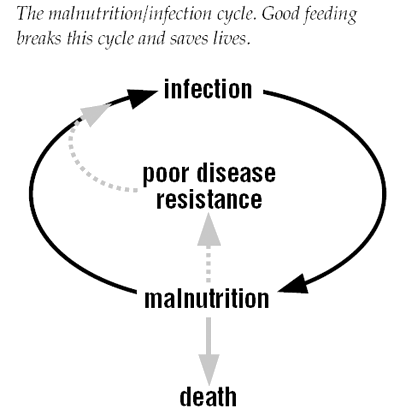
Articles
Feeding young children
by Ann Ashworth. Good food is important for good health. Children who are well fed during the first two years of life are more likely to stay healthy for the rest of their childhood. During the first six months of a child’s life, breast milk alone is the ideal food. It contains all the nutrients needed for healthy growth as well as immune factors that protect against common childhood infections.
2002 Available in English, French, Spanish and Portuguese

Photo: Isabel Carter
by Ann Ashworth.
Good food is important for good health. Children who are well fed during the first two years of life are more likely to stay healthy for the rest of their childhood. During the first six months of a child’s life, breast milk alone is the ideal food. It contains all the nutrients needed for healthy growth as well as immune factors that protect against common childhood infections.
Breast milk continues to be an important source of nutrients until a child is at least two years old. However, after six months of age, all babies need increasing amounts of additional foods, before eventually changing to family foods alone. These additional foods are called complementary foods. As a baby grows and becomes more active, complementary foods fill the gap between the total nutritional needs of the child and the amounts provided by breast milk. Without adequate amounts and a good mixture of these additional foods, babies will fail to grow properly and their immune system will become less effective. Common infections like diarrhoea last longer and are more severe in malnourished children. Once a child is sick, poor appetite can lead to a cycle of ever-worsening malnutrition and repeated infections that often ends in death. Nearly two-thirds of all deaths in children aged 0–4 years are associated with malnutrition in countries in the south – so good feeding practices are of vital importance to child survival.
Complementary foods
Complementary foods should be:
- rich in energy and nutrients
- clean and safe
- easy to prepare
- locally available and affordable
- easy and enjoyable for the child to eat
- not too peppery or salty.
Complementary foods may be specially prepared foods, or be made from mixtures of family foods which are modified to make them easy to eat and high in nutrients. They should be given in small amounts three times a day at first, increasing to five times daily by 12 months. Start with a few teaspoons and gradually increase the amount and variety. It is important to actively encourage a child to eat. A child left alone may not eat enough.
When preparing these foods, make sure all utensils are clean. Spoon-feed complementary foods from a cup or bowl and do not use a feeding bottle. Foods should be used within two hours of preparation if they are not kept in a refrigerator.
Keep a chart of a young child’s weight. Monitoring growth is a useful way to know if a child is eating enough and is healthy.
Complementary foods need to contain sufficient energy, protein, minerals and vitamins to meet the nutritional needs of the growing child. The most difficult nutritional needs to fill are usually for energy, iron, zinc and vitamin A.
Iron and zinc
Foods high in iron and zinc include red meats, liver, kidneys, blood and other kinds of offal. Egg yolks, dark green leaves and pulses are also high in iron, but this iron is not so easily absorbed in the body. However, eating fruit rich in vitamin C (eg: oranges, papaya), at the same meal will improve the absorption of iron.
Using staple foods
Every community has a staple food which is the main food eaten. This may be a cereal (such as rice, wheat, maize, millet), or a root crop (such as cassava, yam, potato), or starchy fruits (such as plantain and breadfruit). In rural areas, families often spend much of their time growing, harvesting, storing and processing the staple food. In urban areas the staple is often bought, and the choice depends on cost. For use as complementary foods, cooked staples can usually be mashed (for example, rice, noodles, cassava, potato), or softened in a small amount of liquid (for example, bread and chapati).
Porridges prepared from the staple are often used as early complementary foods. However, these are usually watery and contain little energy and few nutrients. Soups are also commonly used and are watery, so have the same problems.
Staple foods provide energy. Cereals also contain protein, but most other staple foods have very little protein. However, staple foods are poor sources of iron, zinc, calcium and some vitamins, which are all needed to meet the nutritional need of the growing child.
Useful complementary foods
Other foods must be eaten with the staple food in order to fill the energy and nutritional needs. The types of foods that fill these needs best are:
pulses (such as peas, beans, and groundnuts) and oil seeds (such as sesame seeds). These are good sources of protein. Some, such as groundnuts, bambarra, soybeans and oil seeds, are rich in fat so are also high in energy.
foods from animals and fish These are rich sources of many nutrients but are often expensive. Also, some people do not eat meat because of their religious or personal beliefs. Meat and organs (such as liver, heart, and kidneys), as well as milk, yoghurt, cheese and eggs are good sources of protein. Foods made from milk and any food containing bones that are eaten (eg: small fish, canned fish, or pounded dried fish) are good sources of calcium, needed to build strong bones.
dark green leaves and orange-coloured fruits and vegetables are all rich sources of vitamins A and C.
oils, fats (such as margarine, butter, ghee) and sugars are concentrated sources of energy. Adding one teaspoon of oil or fat to a meal gives extra energy. Red palm oil is also very rich in vitamin A.
Mixing complementary foods is the best way to make certain that children get enough energy, protein and micro-nutrients for healthy growth and development. During a day, a good mixture is:
- a staple + a pulse + an animal food + green leaves or an orange-coloured vegetable or fruit.
Families can use all these foods to make a meal, or they can use, as examples:
- staple + pulse + green leaves at one meal
- staple + animal food + fruit at another meal.
Add a small amount of fat or oil to give extra energy if none of the other foods in the meal is energy-rich.
Anaemia
Children need iron to produce new blood particularly during their first year when growth is fastest. Breast milk contains very little iron, but full-term babies are born with enough iron for their needs in the first six months. After that, if their need for iron is not met, the child will become anaemic. Premature and low birth-weight babies are at higher risk of anaemia because they are born with smaller body stores of iron. Give them iron drops from two months, if available.
Fortified foods
Fortified foods have special nutritional ingredients added by the manufacturers. For example, cereal products may be fortified with iron. Salt may be fortified with iodine. Margarine usually has vitamins A and D added to it by the manufacturer.
Professor Ann Ashworth is a nutritionist at the London School of Hygiene and Tropical Medicine with many years of experience in young child feeding. E-mail is [email protected] Public Health Nutrition Unit, London School of Hygiene and Tropical Medicine, 49–51 Bedford Square, London, UK, WC1B 3DP
Discussion questions
- Discuss the age at which most children start complementary foods in your area. Is this too early or too late? If so, discuss why.
- Are foods from animals eaten in your area? What are they?
- Which of these are regularly given to young children?
- Can you think of ways to make more animal foods available for eating at home, for example, by building a fishpond, or raising rabbits, guinea pigs or poultry?
- Dark green leaves and orange-coloured vegetables and fruits are all rich sources of vitamins A and C. Make a list of those available in your area. What could some families do if there are some months when none are available? Can you help families overcome this lack?

To improve porridges and soups
- Cook with less water and make a thicker porridge.
- Replace some (or all) of the water with milk.
- Add extra energy and nutrients. For example, add milk powder, sugar, margarine or ghee to porridge. Add groundnut or sesame seed paste to soups.
- Toast cereal grains before grinding them for flour. Toasted flour does not thicken much, and uses less water to make porridge.
Take out a mixture of the solid pieces in soups such as beans, meat, vegetables and mash to a thick puree with the staple food. Soften with a little margarine or oil for extra energy. The best part of the soup is the solid foods in it.
Similarly Tagged Content
Share this resource
If you found this resource useful, please share it with others so they can benefit too.

Subscribe to Footsteps magazine
A free digital and print magazine for community development workers. Covering a diverse range of topics, it is published three times a year.
Sign up now - Subscribe to Footsteps magazine




